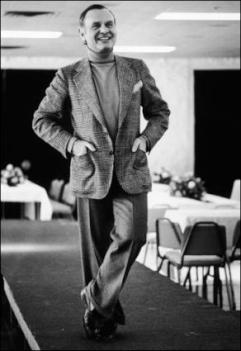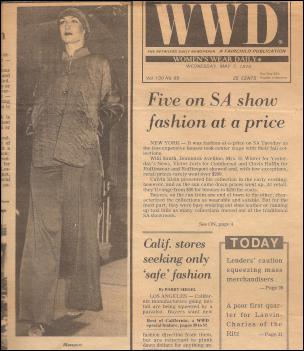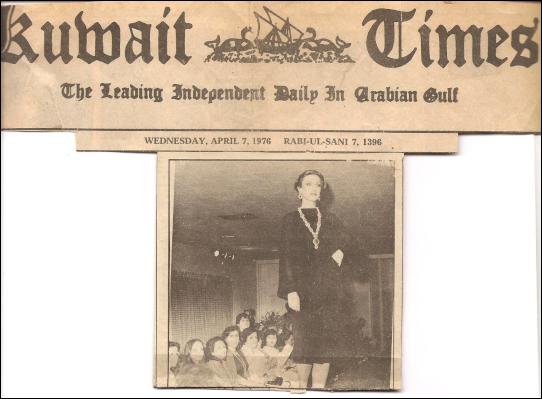Suzan Mazur: Bill Blass - Into The Retro Future
Bill Blass: Into The Retro Future
By Suzan Mazur
RELATED STORIES:
- Geoffrey Beene, Spacewear & DARPA $$$
- Futurist Giorgio Sant' Angelo, An Hommage


On the runway: Bill Blass (l) [source], and Suzan Mazur (r) [
Photo: Bill Cunningham, Women's Wear Daily. '75"]
"With
all the future technology in the world, the intangible thing
will still be attractiveness. You can never beat
it." -- Bill
Blass
The late fashion impresario Bill Blass would have been a natural for commercial spacecraft design and candidate for DARPA's humans-in-space $$$ being awarded in November, having influenced Detroit's production and pitch of the Lincoln Continental. That and his substantial political connections earned him the title, "Senator of Seventh Avenue" in the 1970s. In fact, Blass's real mannequins were not even the fashion industry's runway models, they were the wealthy women who wore his clothes: Nancy Kissinger, Nancy Reagan, Happy Rockefeller, Mrs. Richard Helms, Mrs. Vincent Astor, Nan Kempner, Pat Buckley, Mica Ertegun.
Blass hailed from Fort Worth, Indiana -- actress Carole Lombard's hometown -- and spoke with a Clark Gable, "Frankly, my dear, I don't give a damn" accent. He was a tad impersonal, a private man who cast himself in a public role.
It was not surprising that he visited China in the 1970s in the footsteps of the Kissingers, nor that he drew inspiration from that China moment for his clothing collection. What was surprising was finding myself on the cover of Women's Wear Daily following Blass's May '75 China show wearing his signature coolie jacket.
The backstory is that Reed Evins,
Blass's shoe designer of
the moment, spotted me in the 550 Seventh Avenue elevator en
route to see "Fast Jack" Mulqueen -- who was then
heading New York's Dana Cote d'Azur -- and asked if he could
take me to see Blass first

Suzan Mazur, Dana Cote d'Azur, Photo: Valentin '75"
Once at Blass, I was introduced to Laura Montelban, Blass's assistant and the daughter of actor Ricardo Montelban (also niece of actress Loretta Young, mother of Clark Gable's child). Unbeknownst to me, Montelban's idea was to pair me on the runway with Halston's model since she thought we resembled one another. Blass gave the nod to what I wore and instructed Montelban to: "Give her a shoe with a lift."
I'd actually first met Bill Blass in 1973 on a David Susskind television program, but Blass gave no indication during the fitting that he'd ever seen me before. So I did not bring it up.
The day before the Blass show I cut my hair, which threw Montelban's choreography. As a result, I was sent out onto the runway with my head wrapped in a Chinese turban, which caught the eye of both WWD photographer Bill Cunningham and runway agent Ellen Harth, the former Rudi Gernreich model -- who offered me a contract.
Weeks after the show I ran into Blass at a Park Avenue party, but again he did not recognize me.
The following year I modeled Blass's collection in Kuwait and Iran. My photo appeared in the Kuwait Times on the makeshift runway of Kuwait's Equestrian Club (briefly JIB headquarters during the Gulf War) wearing Blass's black georgette cocktail dress and jewels from David Webb.

Click for big version
Suzan Mazur in Blass on the runway in Kuwait, April '76"
But Blass showed no recollection of me in February 1979 either when we met for a conversation about future fashion for Omni magazine. I ultimately attributed this to his creative brain wiring. Our interview follows:
Suzan Mazur: We both appeared on a David Susskind show a few years ago and I asked you at the time what you thought the next phase in fashion would be and you said you thought it would always be retro.
Bill Blass: It will always come back. Who would have thought, however, that the nostalgia would be for the 40s and 50s? If one tried to forsee what would happen in fashion, there's no reason to believe that we wouldn't go back to Andre Courreges in the 60s. It was the only revolution really. . . .
There was an element of fantasy that existed in the late 60s and early 70s, there's no question. There was a time, for instance, where for women, fantasy dressing reached unbelievable proportions. Even for men there was a real revolution -- probably the first real revolution in menswear in a hundred years. That didn't last long.
Americans -- and I'm talking specifically about Americans as an American designer -- are really very, very conservative, to the point of America being a square nation.
Now I travel all over this country most of the year. And you cannot judge it by New York, which is still more European in its context and in its influence. America once you leave the East Coast is a very conservative, square country. Americans buy clothes with the idea of investment. They buy clothes they can wear more than one season. And they're not taken in by fads. Or perhaps they're not taken in by what is considered fashionable simply because that moment it's considered fashionable. It's one of the reasons fashion magazines have lost some validity.
Suzan Mazur: I spoke with a company at a conference in Atlanta last week that is heat molding women's and men's pants and selling them at Sears for $12.95. It depends on a synthetic thermoplastic fiber, which when heated, can be stretched or elongated. Do you have a comment regarding this mass marketing of heat molded clothes?
Bill Blass: It won't replace Levi's. Mass clothes at the JC Penny, Sears level -- I quite honestly am not even going to hit upon because it's not a subject that I am intelligent about.
Suzan Mazur: One NASA engineer in research and development of life support systems for space has commented that his wife would hate to have him design a dress for her. Do you think the growing desire for functional clothing will, in fact, bring about a necessary marriage of the fashion designer and engineer? And do away with the fantasy element in dress? Will today's ready-to-wear designer lose importance in the culture as did the couturier?
Bill Blass: Absolutely not.
First of all the emergence of the designer as a label and as
a brand name has just begun. The public now goes in [to
stores] and asks for items whether it's an appliance for the
house or -- if a designer's name is attached to it, it has
an added sense of quality, of design, of some mystery.
I
don't think that designers of clothes are restricted only to
apparel. I design and work on a car in Detroit. Twice a year
I fly out and spend a day with the automobile designers and
employees at Ford and then I give my point of
view.
Suzan Mazur: It's beyond apparel.
Bill Blass: It's beyond apparel. I think that while I personally don't get involved in designing kitchen utensils and things of that sort, it's not beyond the realm that one would have at least one's opinion, and one's taste and point of view.
Sears and JC Penny are already starting experiments with designer names. The one thing the public loves is that what they put on their back have that acceptance and signature, that intangible quality of having been designed by a designer. People purchase some clothes purely for utilitarian reasons, for warmth, for cold. By and large they don't.
Suzan Mazur: Do you think then that there is a marriage afoot between engineers and designers -- for instance you're designing cars.
Bill Blass: There you're getting the designer's point of view about lifestyle as opposed to an engineer's point of view, which very rarely extends beyond the community he's working in. I've discovered in working in Detroit, that it is the most insular community I've ever known.
Suzan Mazur: Though it's now possible to reclaim chemicals from synthetic fibers, this process is only being done on a very small scale, due to insufficient funding and it is questionable as to when there will be proper funding. With the nonbiodegradeable quality of synthetic fabric still a problem in the near future, and considering the diminishing quantity of natural fiber -- although strategies are being used to disorient parasites that attack cotton plants and silk worms are being cross-bred in China -- with what material do you intend to clothe people?
Bill Blass: At one time my point of view might have been relatively silly in that I would have said I only use natural fiber. And it's true in my clothes from $500 to $5,000, for the most part those are natural fibers. But a certain amount of polyester, a certain amount of synthetic fabrics are absolutely essentially needed as far as people are concerned.
We use a mixture of polyester or rayon or some synthetic with natural fiber. It would be ridiculous to say I only use natural fibers because I don't. But I do personally prefer cotton, pure cotton, pure silk and pure wool.
The technology of America as far as synthetic fabric goes is so far ahead of the rest of the world that there's no question synthetic fabric is one of our major contributions whether I use it or not.
Suzan Mazur: But how do you feel about the push to make clothes without cutting and sewing?
Bill Blass: I know nothing about it.
Suzan Mazur: The director of Georgia Tech's School of Textile Engineering, which is involved with textile R&D for NASA, has said "the goal of textile and apparel industries should be the development of direct, automatic rapid methods for converting polymer chips and/or staple fiber into garments without spinning, weaving or knitting, cutting, and sewing." The thinking is that cutting and sewing will become obsolete in the industry within 20-30 years.
Bill Blass: It will make cutting and sewing even more attractive.
Suzan Mazur: Couture.
Bill Blass: Yes. I don't see any diminishing in an inflationary period or at a time when there is a tightness among a certain income group. It only means that expensive clothes are easier to sell than ever. . . . It works in a reverse snobism. But I don't design for the masses.
Suzan Mazur: Will China's emergence threaten America's place of leadership in the apparel industry?
Bill Blass: China has a population of 900 million. I went to China in 1975. The biggest problem China has is underemployment. There's not enough work for that many people. There is a vast world out there that can still do hand sewing and it's necessary for their economy to do so.
Suzan Mazur: Could China threaten our leadership position in the apparel industry and are synthetic fabrics -- using heat molding, etc. -- a way for America to ensure our continued relevance?
Bill Blass: Don't forget China is the biggest grower of cotton in the world. Almost all the silk comes from China whether it's processed in Italy or here. Young people who've never had silk or cotton are mad for it. They want a silk blouse. They don't want polyester. A secretary is willing to spend half a week's salary for a blouse.
Suzan Mazur: Some people are working on a polyester fiber they believe will replace cotton.
Bill Blass: Will it wrinkle? Have they found how to make it wrinkle?
Suzan Mazur: They've already done wool. But the cotton is in the developmental stage. It will take a year or two. There's a lot going on with thermal clothes.
Bill Blass: Anything of that sort has great possibilities, if it keeps people warm or keeps people cool. With all the future technology in the world, the intangible thing will still be attractiveness. You can never beat it. We can technically achieve enormous things, but unless a fabric is appealing and attractive, forget it.
Suzan Mazur: You can print on and knit textiles by computer now.
Bill Blass: People hate knitted fabrics. There's an unacceptance of them.
Suzan Mazur: There are all kinds of fascinating things emerging for the mass market.
Bill Blass: Well there's no question the mass market is another world. But even when I talk about the conservatism of America, I talk about conservatism at a high level. At a high price level, spending $1,000.
Suzan Mazur: With a sophistication of the mobile society resulting from military research and development will the civilian interest toward adventure -- campers, backpackers, smaller apartments, mobile homes living -- cause clothes as houses to be considered? Is it conceivable that humans in the near future will be able to travel much like the snail, with a completely transportable personal environment?
Bill Blass: Well I don't think there's any question that we live in an era where people do, the return to travel and to nature has had an enormous effect on people. There are probably many people who would rather spend their money on a mobile home and camping equipment than they would on the gear that goes into it, as long as it's practical.
Suzan Mazur: You can get to untouched spots.
Bill Blass: But there are so few untouched spots left that in the final analysis maybe there will be a greater emphasis on urban civilization. Those who still prefer to live in cities as opposed to the country. Nobody lives in Maine. Everybody moves out. I have a house in Maine, but nobody wants to live there. The biggest problem the state has is that they can't keep young people. Nobody will live there.
I contend that man can live very
attractively and survive for a certain period in nature but
the majority of people really and truly want the excitement
of an urban community.
Look at the size of Los Angeles,
which is one of the dreariest cities, yet more people want
to live there than almost anyplace else in our country.
I
do think, however, that more affluent people tend to live in
the Sunbelt, whether from Florida to the West Coast,
Arizona, anyplace where it's warm. Some of it has to do with
age, which is another factor, but also an amazing number of
young people realize they don't want to be put through
another winter like this [New York winter of
1979].
Suzan Mazur: This design came from a group called Archigram.. It's a completely inflatable unit. This is a permanent spinal structure and this a type of fabric that just. . .
Bill Blass: I'd have such claustrophobia that I'd have to get out of it in 5. . .
Suzan Mazur: It can be converted into an airplane and fold down into a suitcase. It's called a complete nomadic unit. Also a cushicle or suitaloon.
Bill Blass: Cushicle.
Suzan Mazur: What it can do is plug into other units and form an entire city. And the city has no permanence, except in its spinal structure.
Bill Blass: What an awful idea. Perfectly terrible. . .
 Suzan Mazur
is the author of The
Altenberg 16: An Exposé of the Evolution
Industry. Her reports have appeared in the
Financial Times, The Economist, Forbes,
Newsday, Philadelphia Inquirer,
Archaeology, Connoisseur, Omni and
others, as well as on PBS, CBC and MBC. She has been a
guest on McLaughlin, Charlie Rose, and various
Fox Television News programs. For some years along the way,
she was a runway fashion model for Giorgio Sant' Angelo,
Geoffrey Beene, Bill Blass and other legendary designers.
Email: sznmzr@aol.com
Suzan Mazur
is the author of The
Altenberg 16: An Exposé of the Evolution
Industry. Her reports have appeared in the
Financial Times, The Economist, Forbes,
Newsday, Philadelphia Inquirer,
Archaeology, Connoisseur, Omni and
others, as well as on PBS, CBC and MBC. She has been a
guest on McLaughlin, Charlie Rose, and various
Fox Television News programs. For some years along the way,
she was a runway fashion model for Giorgio Sant' Angelo,
Geoffrey Beene, Bill Blass and other legendary designers.
Email: sznmzr@aol.com


 Martin LeFevre - Meditations: Animal Encounters During Meditative States
Martin LeFevre - Meditations: Animal Encounters During Meditative States Ian Powell: Gisborne Hospital Senior Doctors Strike Highlights Important Health System Issues
Ian Powell: Gisborne Hospital Senior Doctors Strike Highlights Important Health System Issues Keith Rankin: Who, Neither Politician Nor Monarch, Executed 100,000 Civilians In A Single Night?
Keith Rankin: Who, Neither Politician Nor Monarch, Executed 100,000 Civilians In A Single Night? Eugene Doyle: Writing In The Time Of Genocide
Eugene Doyle: Writing In The Time Of Genocide Gordon Campbell: On Wealth Taxes And Capital Flight
Gordon Campbell: On Wealth Taxes And Capital Flight Ian Powell: Why New Zealand Should Recognise Palestine
Ian Powell: Why New Zealand Should Recognise Palestine